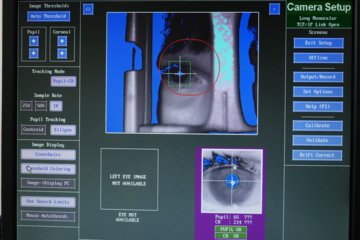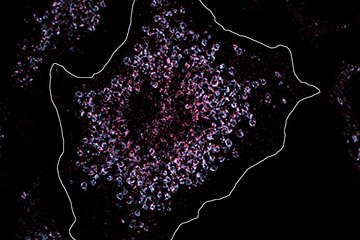Biomolecular explosion
Radioactive radiation could damage biological tissue also via a previously unnoticed mechanism
When cells are exposed to ionizing radiation, more destructive chain reactions may occur than previously thought. An international team led by researchers from the Max Planck Institute for Nuclear Physics in Heidelberg has for the first time observed intermolecular Coulombic decay in organic molecules. This is triggered by ionizing radiation such as from radioactivity or from space. The effect damages two neighbouring molecules and ultimately leads to the breaking of bonds – like the ones in DNA and proteins. The finding not only improves the understanding of radiation damage but could also help in the search for more effective substances to support radiation therapy.

Sometimes radioactive damage cannot be great enough – especially when it comes to destroying tumour tissue with ionizing radiation. In radiation therapy, substances that specifically enhance the damage of the radiation in the tumour tissue are used. “The intermolecular Coulombic decay we found could help make such sensitizers more effective”, says Alexander Dorn, who heads a research group at the Max Planck Institute for Nuclear Physics and was instrumental in the current study. His team’s observations could also improve our understanding of how artificial or natural ionizing radiation damages the genetic material of healthy tissue.
Excess energy leads to a Coulomb explosion
The DNA double helix of the genome resembles a rope ladder with rungs of nucleic base pairs. “Because experiments with the free nucleic bases are difficult, we initially studied pairs of benzene molecules as a model system”, explains Dorn. These hydrocarbon rings are connected in a similar way to the nucleic bases stacked on top of each other in a strand of DNA. The researchers bombarded the benzene pairs with electrons, thereby imitating radioactive radiation to a certain extent. When an electron hit a benzene molecule, it was ionized and charged with a lot of energy. The team has now observed that the molecule transferred some of this energy to its partner molecule. This energy boost was enough to ionize the second molecule as well. Both molecules were thus positively charged. Of course, that didn’t last long. The two molecular ions repelled each other and flew apart in a Coulomb explosion.
Until now, scientists had assumed that ionizing radiation damages biomolecules mainly indirectly. The high-energy radiation also ionizes the water of which a cell is largely composed and which surrounds biomolecules such as DNA. The ionized water molecules – especially hydroxide ions – then attack the DNA. And if an electron of the beta radiation or a gamma quantum does hit a DNA molecule directly, the excess energy normally is dissipated by processes in the molecule itself. It thus remains intact. Or at least that was the assumption up to now. In any case, the weak bonds between different molecules or different parts of the molecule – as they exist in DNA and proteins – should not be affected by this either. However, in their reaction microscope, the researchers observed that radioactive radiation can indeed break such bonds. This instrument allows them not only to detect the two separating benzene molecules and measure their energy but also to characterize the electrons emitted.
Fatal consequences of multiple DNA breaks
“It is not yet clear how the intermolecular Coulombic decay affects the DNA strand”, says Dorn. If a single strand in the DNA ladder breaks, the consequences should not be too serious. However, the mechanism observed also releases several electrons that can “blow up” further pairs of molecules. And if both strands of DNA are broken in the immediate vicinity, this could have fatal consequences.
In order to better assess the effect of the radiation on the genetic material, Dorn’s team will now also bombard pairs of nucleic acids with electrons under the reaction microscope. “This is experimentally challenging because we have to heat the nucleic bases in order to vaporize them”, explains Dorn. “But they must not get too hot either – so that they are not destroyed”. Nuclear doctors can also follow the trail to more effective sensitizers that the Heidelberg team has blazed with the observation of intermolecular Coulombic decay. The mechanism could therefore be relevant for both cases of radiation damage: those that need to be avoided as far as possible and those that should be as great as possible.












